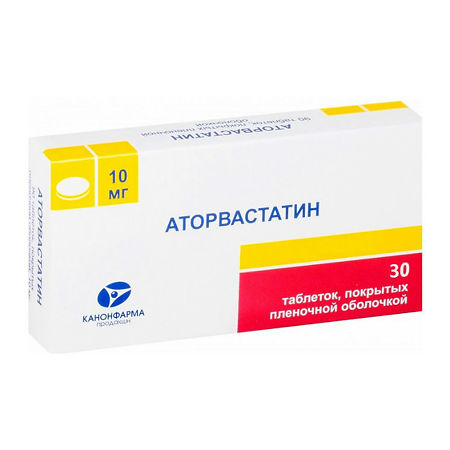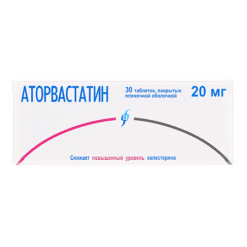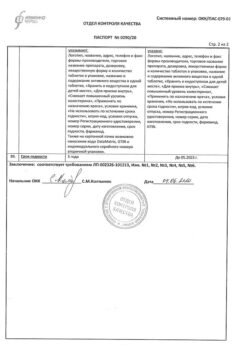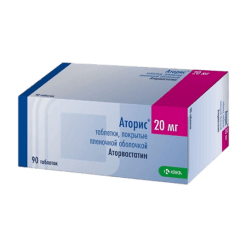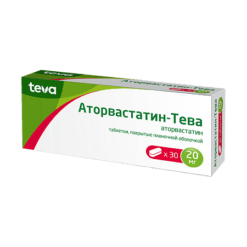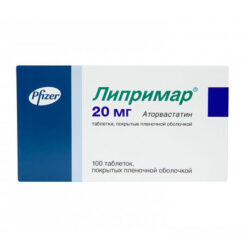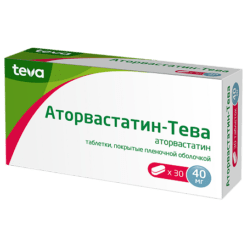No products in the cart.
Atorvastatin, 10 mg 30 pcs
€1.00
Out of stock
(E-mail when Stock is available)
Description
Pharmacodynamics
Atorvastatin is a hypolipidemic drug from the group of statins. Selective competitive inhibitor of HMG-CoA reductase – an enzyme that converts 3-hydroxy-3-methylglutaryl coenzyme A into mevalonic acid, which is a precursor of sterols, including cholesterol. Triglycerides (TG) and cholesterol in the liver are incorporated into very low-density lipoproteins (VLDL), entered into the blood plasma and transported to peripheral tissues. Low-density lipoproteins (LDL) are formed from VLDL during interaction with LDL receptors. Atorvastatin reduces plasma levels of cholesterol and lipoproteins by inhibiting HMG-CoA reductase, cholesterol synthesis in the liver and increasing the number of “hepatic” LDL receptors on cell surface that leads to increased capture and catabolism of LDL.
Decreases formation of LDL, causes a marked and persistent increase in LDL receptor activity. Reduces LDL levels in patients with homozygous familial hypercholesterolemia, which usually does not respond to therapy with hypolipidemic agents. Reduces total cholesterol by 30-46%, LDL by 41-61%, apolipoprotein B by 34-50% and TG by 14-33%; causes an increase in HDL (high-density lipoprotein) cholesterol and apolipoprotein A. Dose-dependently reduces LDL levels in patients with homozygous hereditary hypercholesterolemia resistant to therapy with other hypolipidemic agents.
Pharmacokinetics
Absorption is high. Maximal concentration (Cmax) in plasma is reached after 1-2 hours, Cmax in women is 20% higher, area under the curve/concentration, time (AUC) – 10% lower; Cmax in patients with alcoholic cirrhosis is 16 times higher than normal, AUC – 11 times higher.
Food slightly reduces speed and duration of drug absorption (by 25% and 9%, respectively), but decrease of LDL cholesterol is similar to that with Atorvastatin without food. Concentration of Atorvastatin when administered in the evening is lower than in the morning (approximately by 30%). A linear relationship between the degree of absorption and the drug dose has been found.
Bioavailability is 12%, systemic bioavailability of HMG-CoA reductase inhibitory activity is 30%. Low systemic bioavailability is due to presystemic metabolism in the gastrointestinal mucosa and during “first passage” through the liver.
The average volume of distribution is 381 liters, the binding to plasma proteins is 98%. It is metabolized mainly in liver under the action of CYP3A4, CYP3A5 and CYP3A7 cytochrome with formation of pharmacological active metabolites (ortho- and parahydroxylated derivatives, beta-oxidation products). In vitro, ortho- and parahydroxylated metabolites have an inhibitory effect on HMG-CoA reductase, comparable with that of Atorvastatin. The inhibitory effect of the drug against HMG-CoA reductase is approximately 70% determined by the activity of circulating metabolites.
Extracted with bile after hepatic and/or extrahepatic metabolism (not subjected to marked intestinal-hepatic recirculation).
The elimination half-life is 14 hours. Inhibitory activity against HMG-CoA reductase lasts about 20-30 hours due to the presence of active metabolites. Less than 2% of the oral dose is detected in the urine. It is not excreted during hemodialysis.
Indications
Indications
Active ingredient
Active ingredient
Composition
Composition
1 tablet contains:
The active ingredient:
Atorvastatin calcium trihydrate;
Auxiliary substances:
calcium carbonate;
MC;
StarCap1500 (corn starch and pregelatinized starch);
silica colloidal dioxide (aerosil);
talc;
magnesium stearate;
Opadry II (series 85) (polyvinyl alcohol, macrogol, talc, titanium dioxide, iron oxide yellow dye, iron oxide red dye).
How to take, the dosage
How to take, the dosage
Ingestion.
Before prescribing Atorvastatin, a standard hypolipidemic diet should be recommended for the patient, which the patient should continue to follow during the entire period of therapy.
The initial dose is on average 10 mg/day. The dose varies from 10 to 80 mg/day.
The drug can be taken at any time of the day with food or regardless of the time of meals. The dose is adjusted with regard to baseline cholesterol/LDL levels, the goal of therapy, and individual effect. At the beginning of treatment and/or during dose increase of Atorvastatin it is necessary to monitor plasma lipid levels every 2-4 weeks and adjust the dose accordingly.
In order to ensure the following dosing regimen of the drug it is possible to use Atorvastatin in other dosage forms: film-coated tablets 10 mg and 20 mg. The maximum daily dose of the drug is 80 mg.
In concomitant use with cyclosporine, the daily dose of Atorvastatin should not exceed 10 mg.
Primary hypercholesterolemia and mixed hyperlipidemia. In most cases, it is sufficient to prescribe a dose of 10 mg of Atorvastatin once daily. Significant therapeutic effect is observed after 2 weeks, and the maximum therapeutic effect is usually observed after 4 weeks. With long-term treatment this effect is maintained.
Patient special groups
Kidney function disorders. Administration of the drug in patients with renal insufficiency and renal diseases does not influence on plasma levels of Atorvastatin or degree of cholesterol/LDL decrease with its use, therefore no change of drug dose is required.
Hepatic disorders. In case of hepatic insufficiency, the dose should be reduced.
Elderly patients. No differences in safety, efficacy or achievement of hypolipidemic therapy goals have been noted when using the drug in elderly patients compared to the general population.
Interaction
Interaction
The risk of myopathy during treatment with other statin-derived drugs is increased with concomitant use of cyclosporine, fibrates, erythromycin, azole antifungals and nicotinic acid. When concomitant administration of Atorvastatin and suspension containing magnesium hydroxide and aluminum hydroxide, plasma concentration of Atorvastatin was decreased by approximately 35%, but the degree of decrease in LDL-C levels did not change. In concomitant use Atorvastatin does not affect pharmacokinetics of antipyrine (phenazone), therefore interaction with other drugs metabolized by the same cytochrome P450 isoenzymes is not expected.
Special Instructions
Special Instructions
Before and during treatment with Atorvastatin, especially when symptoms of liver damage appear, liver function parameters should be monitored. If the level of transaminases increases, their activity should be monitored until normalization. If AST or ALT activity, more than 3 times higher than normal, persists, it is recommended to reduce the dose or to cancel Atorvastatin.
Contraindications
Contraindications
The drug should be used with caution in patients with chronic alcoholism, history of liver disease, severe electrolyte balance disorders, endocrine and metabolic disorders, arterial hypotension, severe acute infections (sepsis), uncontrolled epilepsy, extensive surgical interventions, trauma, skeletal muscle diseases.
Side effects
Side effects
Nervous system disorders: insomnia, dizziness; headache, asthenia, malaise, somnolence, nightmares, paresthesias, peripheral neuropathy, amnesia, emotional lability, ataxia, facial nerve paralysis, hyperkinesias, migraine, depression, hypoesthesia, loss of consciousness.
Senses: amblyopia, tinnitus, dry conjunctiva, accommodation disorder, retinal hemorrhage, deafness, glaucoma, parosmia, loss of sense of taste, perversion of taste.
Cardiovascular system: chest pain; palpitations, symptoms of vasodilation, orthostatic hypotension, increased BP, phlebitis, arrhythmias, angina pectoris.
Hematopoietic system disorders: anemia, lymphoadenopathy, thrombocytopenia.
Respiratory system: bronchitis, rhinitis; pneumonia, dyspnea, exacerbation of bronchial asthma, nasal bleeding.
Digestive system disorders: nausea; heartburn, constipation or diarrhea, flatulence, gastralgia, abdominal pain, decreased or increased appetite, dry mouth, belching, dysphagia, vomiting, stomatitis, esophagitis, glossitis, erosive and ulcerative lesions of the oral mucosa, gastroenteritis, hepatitis, biliary colic, cheilitis, duodenal ulcer, pancreatitis, cholestatic jaundice, liver dysfunction, rectal bleeding, melena, bleeding gums, tenesmus.
Muscular system disorders: arthritis; leg muscle cramps, bursitis, tenosynovitis, myositis, myopathy, arthralgia, myalgia, rhabdomyolysis, torticollis, muscle hypertonicity, joint contractures, joint swelling, tendopathy (in some cases with tendon rupture).
Urogenital system: urogenital infections, peripheral edema; < 1% – dysuria (including Pollakiuria, nycturia, urinary incontinence or urinary retention, imperative urge to urinate), leukocyturia, nephritis, hematuria, vaginal bleeding, nephrourolithiasis, metrorrhagia, epididymitis, decreased libido, impotence, ejaculation disorders.
Dermatological reactions: alopecia, xeroderma, photosensitization, increased sweating, eczema, seborrhea, ecchymoses, petechiae.
Endocrine system disorders: gynecomastia, mastodynia.
Metabolism disorders: weight gain, aggravation of gout.
Allergic reactions: skin itching, skin rash, contact dermatitis, rarely – urticaria, angioedema, facial edema, anaphylaxis, erythema multiforme (including Stevens-Johnson syndrome), toxic epidermal necrolysis (Lyell’s syndrome).
Laboratory measures: hyperglycemia, hypoglycemia, increased serum CPK, albuminuria.
Overdose
Overdose
Treatment: there is no specific antidote, symptomatic therapy is carried out. Hemodialysis is ineffective.
Pregnancy use
Pregnancy use
Atorvastatin is contraindicated during pregnancy and lactation (breastfeeding).
It is unknown whether Atorvastatin is excreted with breast milk. Taking into account the possibility of adverse events in breastfed children, if it is necessary to use the drug during lactation, the question of stopping breastfeeding should be considered.
Women of reproductive age should use adequate contraceptive methods during treatment. Atorvastatin can be administered to women of reproductive age only if they are very unlikely to become pregnant and the patient is informed about the possible risks of treatment for the fetus.
Similarities
Similarities
Additional information
| Weight | 0.013 kg |
|---|---|
| Shelf life | 2 years |
| Conditions of storage | In a dry, light-protected place at a temperature not exceeding 25 °C |
| Manufacturer | Kanonfarma Production ZAO, Russia |
| Medication form | pills |
| Brand | Kanonfarma Production ZAO |
Other forms…
Related products
Buy Atorvastatin, 10 mg 30 pcs with delivery to USA, UK, Europe and over 120 other countries.

